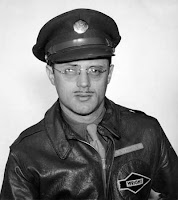In late 1944 a new type of fighter appeared in the skies over Germany, and it did not have a propeller. The Messerschmitt Me-163 looked like something out of a Science-Fiction comic book, or a serial episode of Flash Gordon, a Nazi rocket wonder with a swastika on the tail. This was the only manned rocket-powered aircraft ever to see operational service. It could climb to 30,000 feet and engage American B-17 bombers in roughly two-minutes after it took-off. With enough fuel for 7.5 minutes of rocket power, the Me-163 "Komet" had about five minutes to engage and shoot down as many American aircraft as possible, if the American bomber's fighter escorts didn't get the Me-163 in their sights first. For all the hype generated by the Nazis over this "wonder weapon", the Me-163 only shot down between 9 and 18 enemy aircraft, a drop in the bucket when you consider in just a single bombing raid against Germany, Allied aircraft numbered in the hundreds.
The Messeschmitt Me-163
Not to be left out of the rocket race, the United States came up with a design that actually was a rocket fighter. It literally sat atop a separate rocket, was blasted off, then detached once it had altitude and its fuse was lit. It was designed and illustrated by Alex Tremulis. A pre-war automobile industry concept artist, Tremulis' designs were the height of the streamlined art deco movement. In the 1930s it was all about Air and Space. Everything from cars to boats, to buildings and aircraft, even toasters and household furniture had a design that might star in a Flash Gordon film.
Tremulis' design for a bubble-top automobile, 1936
During the Second World War, Alex was employed by the Army Air Force as an illustrator and concept artist. One of his most challenging tasks was to reconstruct, on paper, a captured V2 German rocket from a twisted mass of hardly recognizable metal, as the Army wanted a picture of what it looked like in one piece because at that point in the War, the Allies had no clear picture of what it looked like.


The Tremulis Zero Fighter was his contribution to the race for advanced weaponry. The Allies knew full well the Germans, Italians, Japanese were designing, creating, and implementing advanced projects to throw against them in the hopes of winning the War, they just didn't know the full extent ad were desperate to keep up. Called it the Tremulis Vertical Take-off, or TVT, and was his own personal design. After take-off, it would blast up to where the pilot wanted to engage them enemy and jettison the rocket portion of his craft. At this point, his aircraft's rocket engine would ignite and he could get about the business of shooting down the enemy. As the air is much thinner at higher altitudes, Tremulis designed a system of compressed air jets to maneuver the fighter where ailerons would not be as effective. Once the rocket plane's fuel ran out, it would glide back to earth, just like the Me-163.


While never considered feasible during WWII, Alex Tremulis's designs would go on to inspire the Bell X1 made famous by Chuck Yeager when he piloted this craft and officially broke the sound barrier in 1947. Some aspects of his design work, even from this early date, were used in developing the Space Shuttle in the 1970s. After the War, Tremulis went back into the automobile industry, and in the late 1940s he worked for a man named Preston.

The Bell X1
Most have never heard of Alex Tremulis but they know of his most famous car design. He almost single-handedly produced this design for the most famous, infamous and rarest American automobile ever produced. He worked for Preston Tucker, and the 1948 Tucker Torpedo, one of the rarest cars in the World, came from the drafting table of Mr. Tremulis.
1948 Tucker
Alex Tremulis in 1941
Tremulis Zero Fighter Concept Drawing












